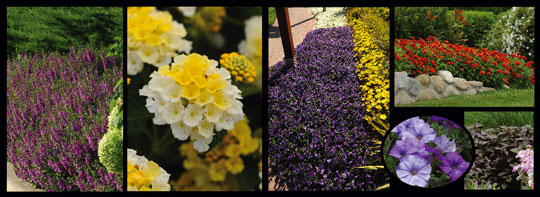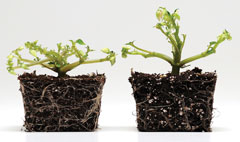4/27/2011
New Varieties for Landscapers
Jeff Gibson

As we enter the heat of the spring 2011 installation season, there are three new landscape market realities for landscape growers to consider:
- Number of color rotations is down.
- Value expectation is higher.
- Plants are expected to last longer.
To that end, landscape contractors—and the growers who supply them—will continue to pay close attention to the latest varieties coming to market, as new improvements can make them more efficient on the job site and ultimately more successful with clients.
The good news: It is still true that “Color is King” in getting repeat commercial and residential business for landscape contractors. Most landscape contractors will agree that there is no greater item that, when done well, contributes more to client satisfaction than a color installation. That said, contractors are turning more and more to their growers and suppliers to help them provide greater planting efficiencies, greater color longevity and lower maintenance.
Greater efficiency in plantings
Landscapers are constantly on the lookout to save their clients money and expense. Growers who sell to the landscape trade can offer the following examples as a valued service for their customers:
- “Pre-racked” orders by job site. This helps make the landscaper’s unloading process faster and more efficient.
- Coordinated shipping and/or centralized drop-off of plants to job sites in one area.
- Greater use of mixed or “blended” bedding plant color items, especially pre-mixed items in more appealing tones and shades. Mixes take the guesswork out of planting and speed up installation time.
- Offering “plantable pot” alternatives, such as Ellepot or the new SoilWrap from Ball. Eliminating the step of removing the plastic pots saves on plastic waste as well as up to 30% time savings at planting.
Plant longevity
Further educating landscape contractors on the varieties that will perform best in their applications is a win-win-win all around. The grower becomes a trusted resource, the landscaper installs plants that thrive longer, and the client enjoys an extended, more satisfying color season. Growers can help their landscape customers with plant longevity concerns by identifying and providing:
- Plants that can go in earlier and last through the summer.
- Plants that, when planted in the fall, overwinter and “bridge the gap” to provide early spring color before the summer installation occurs. This overwintering “bounce back” can help eliminate seasonal color gaps for clients while still reducing their color turns.
- Plants that can last longer later in the season and still look colorful.
Lower maintenance
Plant maintenance costs are typically squeezed in client contracts in order to reduce costs. Identifying plants with low-maintenance needs can help meet today’s tighter budget constraints. Examples of this are plants that need less watering, less deadheading or less fungicide to keep them looking great all season.
Multi-season interest
Your landscape customers are likely requesting newer items that offer multi-season interest. Perennial and shrub sales are on the rise to the landscape trade. Recent Ball survey data (see page 58) shows a general increase in use of perennials within the landscape trade. Growing varieties that offer spring bloom, as well as summer interest and fall color, will increasingly meet these needs.
Plant choices may be shifting as a result of a plant’s “function,” as well. Natives, perennials, grasses and shrubs are more in demand now to slow water movement, prevent erosion, provide shade for buildings or HVAC units, and attract or abate wildlife.
Client value expectation and cost reduction are keys to succeeding in today’s competitive landscape maintenance environment. Landscapers are turning to their growers more than ever to help them identify varieties that provide these attributes. New classes of plants and twists on old standards have appeared, as well as renewed interest in timeless classics.
Many landscapers in the upper Midwest, Northeast and Southeast are struggling with their petunias. Late-season dieback is often attributed to hot, wet conditions that adversely affect all petunias in beds that have seen too many plantings of petunias year after year. A grower’s best advice? Suggest yearly plant rotation in the affected beds! Great alternate crops to petunias for a season or two are lantana, coleus or angelonia.
 ANGELONIA
ANGELONIA
Angelonia is quickly becoming the workhorse of the landscape trade. Angelonia does well in large landscape plantings, and also containers and hanging basket combos. The vegetative AngelMist series (particularly AngelMist Spreading Angelonia) thrives in extremes: heat, humidity and low water conditions. AngelMist Spreading is a great flowering groundcover. It finishes in the landscape at around 6 in. with a more than double vigorous spread.
Gaining momentum on the seed side is Serena Angelonia. It has very low shatter, so it stays compact and tidy. Serena is ideal for premium packs, allowing more affordable mass plantings for greater color impact.
New Varieties: Serena Blue Angelonia; AngelMist Spreading Purple Angelonia
IMPATIENS MIXES
As previously mentioned, offering more pre-mixed or color blends can take the guesswork out of planting for landscapers. It speeds up installation time, too. Impatiens is one of those varieties that offer endless mix possibilities. The
Impatiens walleriana Super Elfin XP series has a tight flowering window across all its colors, so landscapers can install uniform mixes. Dazzler is considered the most landscape-friendly Impatiens series with healthy plants and free-flowering habits all season.

Impreza Impatiens habit comparison. The plant “skeleton” of Impreza (left) results in better holdability than standard Impatiens (right).
The new Impreza Impatiens series has been selected for greater branching. More branching means more flowers and allows for a tidier, shorter plant habit in the landscape so it lasts longer into the season without stretch. New Guinea Impatiens offer strong color with big blooms that are excellent in the shade. The seed-grown Divine series allows for premium pack growout for higher density landscape plantings.
New Varieties: Super Elfin Sedona Mixture; Dazzler Passionfruit Mixture; Divine Hot Mixture; Impreza Wedgewood Mixture
LANTANA
Improvements are being made on this “classic” landscape performer. Lucky Lantana series has a more controlled habit perfect for containers and groundbeds where you don’t want Lantana to take over. This translates to lower maintenance. Ball is working to increase the sterility in this line. Less fruit set means greater flowering and longevity in the landscape.
New Varieties: Lucky Pure Gold; Lucky Lemon Glow
PANSY
The New Plentifall Pansy series is a vigorous trailer/spreader and an awesome season extender. Plentifall has superb hardiness and will overwinter, so it will be the first to bloom in the spring. A perfect “bridge” plant for fall to summer color rotations.
New Varieties: Plentifall Lavender Blue; Plentifall Yellow; Plentifall Mixture
WAVE PETUNIAS
Wave spreading petunias are a “landscape classic” for most landscape contractors. They provide season-long color, quick fill, a spreading habit and bounce back from rainstorms. The Shock Wave series in the Wave family has superb weather tolerance. Loads of small blooms on a tidy mounded plant habit make them a natural for street baskets and containers. Try the Denim color first! It has a great multi-color feature that changes hue from deep violet to silvery tones in the landscape.
New Varieties: Wave Purple Improved; Easy Wave Neon Rose; Shock Wave Denim
ZINNIA
Crossing
Z. elegans (“Pom Pom” type) with
Z. augustifolia yields an interspecific hybrid line of
Z. marylandica. These are without question the best zinnias for the landscape. The newer double flower form of the Zahara series provides greater visibility for the “filled-in color” look landscapers want to provide their customers.
New Varieties: Double Zahara Cherry; Double Zahara Fire
Other crops to consider
Landscape color through foliage is a sure-fire way to address seasonal color longevity with a minimum of bed maintenance. Typically, disease- and pest-free items like Purple Knight Alternanthera, Silver Falls Dichondra, Blazin’ Rose Iresine for shade, and low-growing, colored groundcover Purple Lady Iresine give you booming color without the bloom. The new Gryphon Begonia is a rock star for the shade garden. Big silver-streaked leaves make a lasting impression. Its large, quick-growing habit makes for a striking specimen or container planting.
Ornamental Grasses, much like accent foliage, are perfect choices for cost-conscious landscapers. The ColorGrass seed-propagated line from PanAmerican Seed provides economical, continuous form and color in the landscape. Grasses are very low maintenance and many provide overwintering characteristics that help the budget-conscious client see the value from fall to spring to summer again!
Perennials are not the end of annuals! They should augment what you already grow. Items like Tiger Eye Rudbeckia, Mesa Gaillardia and PowWow Echinacea provide the hardiness of true perennials with the continuous color show of an annual.
GT
Jeff Gibson is landscape business manager for Ball Horticultural Company. He can be reached at 630-588-3468 or jgibson@ballhort.com. Explore all your landscape needs at www.BallLandscape.com.